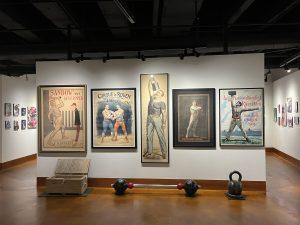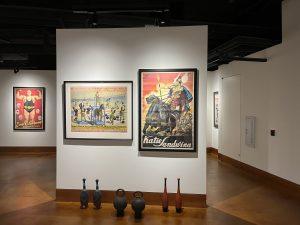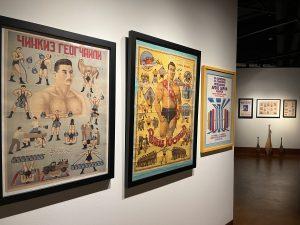Lithography, a printmaking practice invented in 1796, allowed for the seemingly limitless duplication of text and illustration by applying crayon to limestone and then rolling ink over the top. It was still a relatively new medium when technological advances at the end of the 19th century led to the production of prints in larger sizes and with multiple colors—the birth of eye-catching posters. The innovation began to inspire the advertising industry and artists alike. Henri de Toulouse-Lautrec is, perhaps, the most famous bridge between promotional lithographs and high art. A contemporary of Van Gogh, Lautrec’s posters for working-class dance halls, such as the Moulin Rouge, elevated the Parisian neighborhood of Montmartre and portrayed its budding nightlife culture in a glamorous light and alluring color palette.
As strongmen and strongwomen began appearing in Vaudeville and the circus, they used the same advanced lithographic techniques to publicize their acts. Now highly collectible, these early posters can be read as both a historical vision of what their act might have included and as works of art in their own right. Printed on thin paper, very few of these early posters have survived. One of The Stark Center’s missions has been to collect and preserve as many of these historic prints as possible.
We decided to create a “strength poster” exhibition based on the several hundred posters we now hold here at The Stark Center related to both professional athletes and competitive weightlifting. In this room, you’ll find posters for an assortment of strongmen and strongwomen who performed in the United States, Europe, and even Western Asia. Two recent additions, for example, feature text in the Cyrillic alphabet and advertise strongmen from the nations of Georgia and Azerbaijan, a region which has long been a hotbed for champion wrestlers and strength athletes. Among the rarest items on display are the original poster featuring Katie Sandwina’s 1920s act in which she arrived on stage in a chariot and the 1901 French poster-calendar featuring six international strongwomen.
Other posters are currently on display in the Teresa Lozano Long Fine Art Gallery and The Stark Center Reading Room.
*In German, “Stark” means strong.





